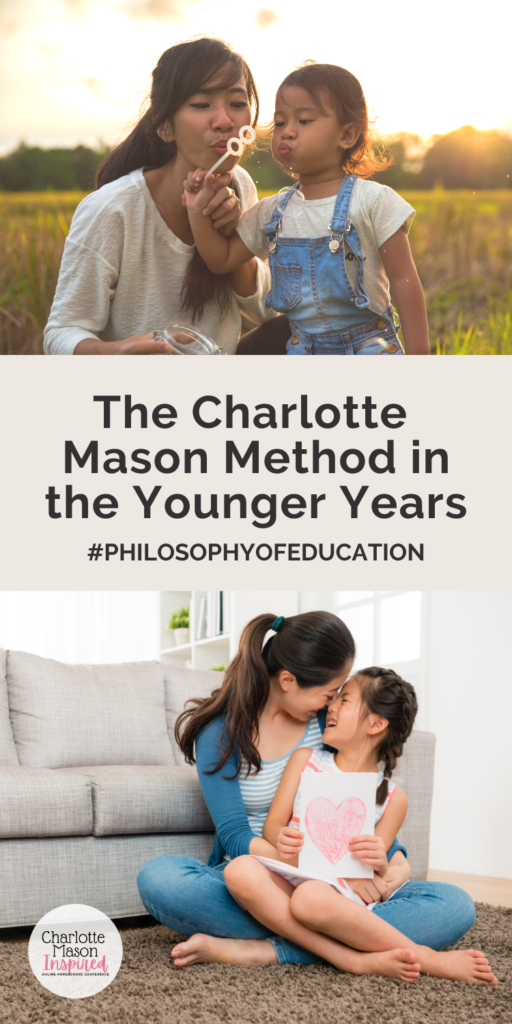I like to say that Charlotte Mason is the reason I began homeschooling. My oldest child was only two years old when I stumbled upon a blog in which the author was homeschooling with the Charlotte Mason method. My eyes were opened to the possibility of teaching children with living books, nature, and the fine arts and I was hooked.
With only very young children at home to teach, I scoured the internet for ideas on how to implement the Charlotte Mason method in the younger years. So my journey into the Charlotte Mason homeschooling began. I read every book I could find on the subject, and I began to feel my way through what would become our journey with the Charlotte Mason method.

How To Implement the Charlotte Mason Method in the Younger Years
I’d like to share the three pillars of a Charlotte Mason preschool or kindergarten with you. Miss Mason did not suggest children begin formal lessons until age six, and I have found through my experience that is the best age to start having children sit for lessons. Now, you can absolutely teach your child the alphabet and how to count before age six, but this should be a fun, no pressure time.
So, if we aren’t concentrating on formal lessons, what are we concentrating on?
Habits
Let’s talk a bit about habits. If you think about it, almost everything we (as humans) do is some sort of habit. We wake in the morning and most likely have some sort of routine. Before you even begin to try to teach your child, you need to work on habits.
I would begin with very young children and the habit of cleanliness. Teach your child to get dressed in the morning, comb their hair, brush their teeth. Of course, you’ll have to do this with your child in the beginning, but before long, the habit will be ingrained in the child.
A child as young as two can work on keeping his space clean. Teach your child to pick up his toys. Here’s the thing, though, always have your child put his toys away. If you let it slip and start putting the toys away for the child, the only thing you are teaching him is that it doesn’t matter if he does it because Mom will come back and do it anyway.
Another habit that Charlotte Mason thought was important for young children was the habit of attention. Attention is a mental habit that will serve the child well during his education. One way Miss Mason says that we can help train our young children in attention is to help them really observe the objects they come in contact with.
For example, if your child plucks a daisy you will notice he will probably throw it to the side after a few seconds. To help with his attention, you can pick the daisy up and show it to the child. Talk about the colors of the flower and how it looks like a yellow eye with white eyelashes.
You can read more about habits and their importance in Home Education, the first volume in the Charlotte Mason series.
Living Books
I would say that before you even begin to think about teaching your child the alphabet that you read your child good, quality books. Books are wonderful. They are full of ideas, they take us to worlds we would never be able to visit, they help us make connections, and I believe they are of utmost importance to a child’s education.
If you want some ideas of quality literature for very young children, check out my preschool book lists.
Read before bed, read after lunch, always take the opportunity to read to your child!

Outside Play
The final pillar of a Charlotte Mason preschool or kindergarten for me is outside play. Get your kids outside! Charlotte Mason specifically wrote about the Out-of-Door Life for Children in Home Education. Have meals outside when the weather permits. Miss Mason did suggest that mothers spend hours and hours outside with their children every day. Honestly, in our society today that is probably not possible, but I do believe that our children should spend as much time outdoors as possible.
When they are outside, they should be put in the way of nature. Let them explore the flowers, the rocks, the soil. Observe the trees as they change through the seasons. Help your child develop a relationship with nature.
So, habits, living books, and outside play are the three main components of a Charlotte Mason preschool. What about when your child is ready to start learning letters and numbers?
I have created My Homeschool Preschool Planner to help me put all of my plans together. This planner is inspired by the Charlotte Mason method and helps me be intentional with my youngest learners. I can plan habits, outdoor time, circle time, and read-alouds with my preschool and kindergarten kiddos so they do not get lost in our day while I’m teaching the older children.
